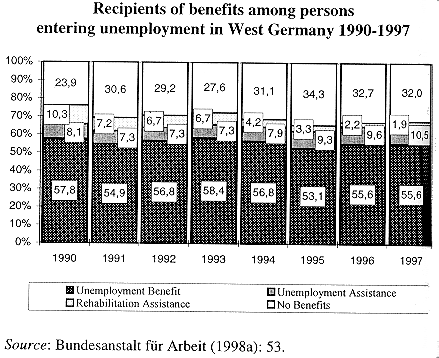

![[DIGITALE BIBLIOTHEK DER FES]](/images/digbib/d_digbib.gif)

SECTION of DOCUMENT:
-
UNEMPLOYMENT IN WEST GERMANY:CURRENT ASPECTS AND LONG-TERM TRENDS
- 1. Unemployment in West Germany: The Development over the Past Five Decades
- 2. Unemployment and the Unemployment Rate: Different Definitions
- 3. Is Official Unemployment Only the Tip of the Iceberg?
- 4. Benefits for Persons Affected by Unemployment
- 5. Unemployment in 1997: How Are Different Groups Affected?
- 6. What Becomes of the Unemployed?
- 7. Which strategies are most useful for coping with this challenge?
- NOTE
- REFERENCES
Susanne von Below, Frankfurt am Main
[page-number of print edition: 52]
UNEMPLOYMENT IN WEST GERMANY:
CURRENT ASPECTS AND LONG-TERM TRENDS
Susanne von Below, Frankfurt am Main
As in many other countries, unemployment is a very significant issue in Germany. Around eighty percent of the population name it as the most important problem1 (Forschungsgruppe 1999). In the two parts of Germany, the history, structure, and reasons for unemployment are quite different and have divergent sets of reasons. This paper will concentrate on unemployment in West Germany.
After an overview on the development of unemployment since the 1950´s and a discussion of terms and indicators used for describing unemployment, an analysis of the structure of unemployment as it exists today in West Germany will follow. There will be a special emphasis on groups that have greater difficulties on the job market than others. The paper will close with some proposals for solving the problem of unemployment, as they are being discussed in Germany at present.
1. Unemployment in West Germany: The Development over the Past Five Decades
As shown on Figure 1, the absolute number of unemployed persons has changed considerably in the course of the past 50 years.
[page-number of print edition: 53]
Figure 1
Unemployed persons in West Germany 1950-1998
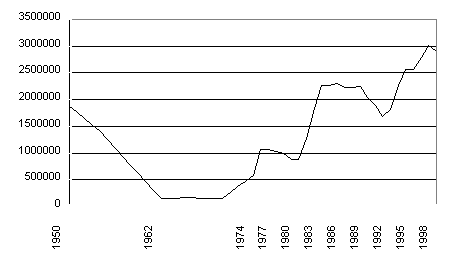
Source: Bundesanstalt für Arbeit (Ed.): ANBA Sondernummer: Arbeitsmarkt 1997; Pressemitteilung 03/99.
After an early high in the post war times, when the economy had to develop and many refugees needed to be integrated into the labour market, the numbers of unemployed persons fell steadily and stayed around 200,000. There was a sudden rise to about 400,000 in 1967/68 which is not shown here because data until 1974 are for every four years. From the early seventies on, unemployment numbers climbed constantly. There were only short breaks in the second half of the seventies and in the early nineties. The latter was due to increased demand from East Germany.
In this paper, most data are for 1997, since detailed analyses are available for that year. For overall numbers, though, the 1998 data are already at hand. Most of the data are yearly averages, in order to exclude seasonal differences.
[page-number of print edition: 54]
In 1997, the yearly average number of unemployed persons in West Germany was 3,020,900 (2,904,300 in 1998). This shows that unemployment is not only very important in the perception of the population, but it does pose an immense problem to the country and constitutes a great challenge to politics.
2. Unemployment and the Unemployment Rate: Different Definitions
The number of unemployed persons as used here is the number of people who are currently out of employment - or work only very little, who are available for new employment, who have registered at one of the official employment offices and renew this registration regularly, who live in Germany, and are under the age of 65. This number of the officially registered unemployed persons differs from and is higher than the one used by ILO-standards, which is taken from representative surveys and consists of those who have not worked during the past seven days, have been looking for work during the previous four weeks, and are available to start work within the next two weeks.
In Germany, two different definitions of unemployment rates are being used:
- The number of officially registered unemployed persons in relation to the dependent civilian labour force (those currently in employment subject to social security - including civil servants except military, including apprentices and those marginally occupied who do not have to pay into the social security - plus the unemployed). This percentage has risen from 9.3 % in 1985 to 11.0% in 1997 and gone back down to 10.5% in 1998.
- Since 1994, the German government uses a different official unemployment rate: The ratio of registered unemployed persons to all civilian labour force including self-employed persons. Thus self-employment is becoming a way out of unemployment for more and more unemployed persons and for those help-
[page-number of print edition: 55]
ing/working within the family. This lowers the official unemployment rate to 8.2% in 1985, 9.8% in 1997, and 9.4% in 1998.
The definition that is being used in this paper is the first one, as most researchers consider it more appropriate since self-employed persons carry a very low risk of becoming unemployed and would have no right to claim unemployment benefits. The two rates can be compared on Figure 2.
Figure 2
Unemployment rates in West Germany by different definitions 1989-1998
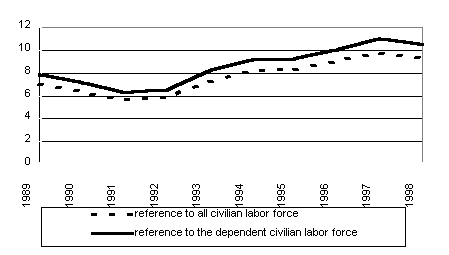
Source: Bundesanstalt für Arbeit (1998 and 1999).
3. Is Official Unemployment Only the Tip of the Iceberg?
Officially registered unemployed persons make up only a certain part of those actually looking for employment or those in need for more employment than they actually have at a certain point of time. There are certain groups that are not unemployed but would be available if the labour market situation allowed.
[page-number of print edition: 56]
- One very important group are those who take early retirement and are no longer available for the labour market. This group consisted of about half a million persons in 1997.
- The second substantial group of persons available for the labour market that is not officially registered as unemployed are the „hidden reserves„; They include those persons currently taking part in labour market activities as can be seen on Fig. 3:
Figure 3
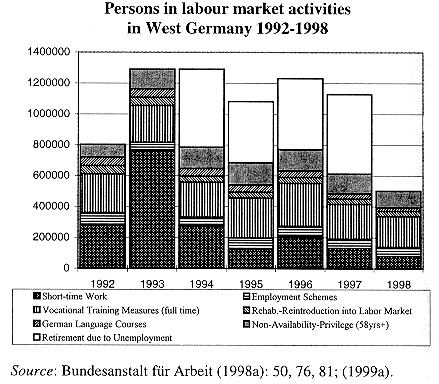
This group consists of persons in full-time vocational training measures, in employment schemes, German language courses, and rehabilitation and reintroduction into the labour market. Persons 58 years and above are eligible for the Non-Availability-Privilege which grants them unemployment benefit but does not
[page-number of print edition: 57]
consider them as unemployed, since they can assume the privilege of not being available for a new job. Persons 60 years and above who have been unemployed for at least one year can enter early retirement due to unemployment.
- The other group of persons within the hidden reserves are those who would like to work and would be available if the right job was offered to them. Estimations for this particular group vary greatly, since there are no specific data available about it.
- Another extensive group of people that is not considered unemployed but does not hold a full job is the group working short-time. Their number has gone up and down considerably over the past decade. The average lost working hours for those working short-time were 41% in 1997.
In the following, only the officially registered unemployed persons will be dealt with, since they are covered by data that are being published regularly. So, the situation at a given point of time and the development over a certain period of time can be looked at.
4. Benefits for Persons Affected by Unemployment
Most of the registered unemployed persons receive unemployment benefits. Of the 4,926,303 persons entering unemployment in West Germany in 1997, 55.6% received „Arbeitslosengeld„ which is unemployment benefit as a certain percentage of the former wage that almost everyone who paid into unemployment insurance is entitled to for a certain period of time depending on the duration of his payments. Additional 10.5% received „Arbeitslosenhilfe„ which is unemployment assistance granted if the person is needy and his or her entitlement to unemployment benefit has not been acquired yet or has run out. Some 1.9 % of people entering unemployment receive „Wiedereingliederungshilfe„ which is rehabilitation assistance. Over the course of time, especially the rate of receivers
[page-number of print edition: 58]
of rehabilitation assistance has varied, depending on financial resources and political backing for courses and training programs, as can be seen on Figure 4.
Figure 4
The rate of recipients of unemployment benefit, unemployment assistance or rehabilitation assistance is higher among the overall unemployed than among those new in unemployment, since those without claims for benefits are unemployed for shorter periods than those receiving benefits.
Although many unemployed persons receive benefits, the poverty rate among unemployed persons was 33% (by the definition of poverty as everyone under 50%-net equivalent per capita income) in 1995 in West Germany, compared to 13% average (8.8% for the employed) (Statistisches Bundesamt 1997: 523).
[page-number of print edition: 59]
5. Unemployment in 1997: How Are Different Groups Affected?
Different population groups are affected differently by unemployment (Bundesanstalt für Arbeit 1998a: 52):
- Differences by sex:
Figure 5
Activity and unemployment rates of women and men
in West Germany 1970-1998 in percent
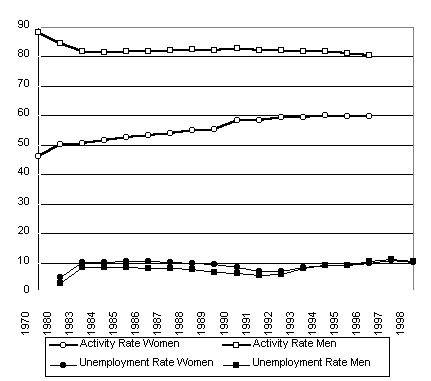
Note: From 1990 on employments not subject to social security are included.
Source: Bundesanstalt für Arbeit (1998a): 101, 104; (1998b): 38.
[page-number of print edition: 60]
The activity rate of men, as shown on Figure 5, has gone slightly down to around 80%, whereas the activity rate of women - since 1991 including those who are „marginally occupied„, not subject to social security - has come up to around 60% where it has been stable since 1990. Until 1993, the unemployment rate of women was higher than that of men. This changed in 1994, where men and women had the same unemployment rate. Since 1995, unemployment is higher among men than among women. Men have - at 11.2% - a higher rate of unemployment than women whose rate of unemployment is 10.7% (42% of unemployed are women). In 1997, though, the unemployment rate of women has risen more (9%) than that of men (8%), and the actual monthly data for 1998 and 1999 show a greater unemployment of women than of men. (Bundesanstalt für Arbeit 1998a: 102.)
- Differences by occupational status:
62.8% of the unemployed are blue collar workers, 31.2% are white collar workers. The rate of unemployment among white collar workers has risen slightly more (by 10%) than that of blue collar workers (7%) in 1997, but all in all, those relations are pretty stable.
[page-number of print edition: 61]
- Differences by age:
Figure 6
Percentages of different groups of persons among registered unemployed persons in West Germany 1980-1997
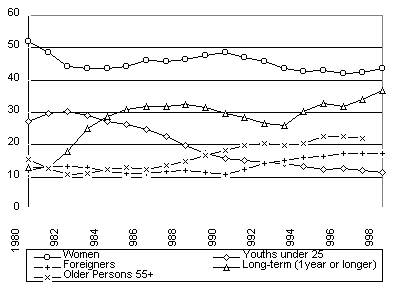
Source: Bundesanstalt für Arbeit (1998a): 49; (1999a).
On Figure 6, the changing rates of different groups among unemployed persons over the course of time can be seen. Since 1981, women have made up less than half of the unemployed.
Youths (under the age of 25) make up 12.0% of unemployed people in West Germany in 1998. This percentage has fallen steadily from 30.3% in 1982. So their percentage of the overall unemployment has fallen, whereas the unemployment rate of young persons has risen since 1990 (overall unemployment rate: 7.4%, under 20´s: 4.6, 20-24 year olds: 6.1%). Their unemployment rate is 11.1% in 1997, now slightly above the overall average. Unemployment among those under 20 is much lower (-1%
[page-number of print edition: 62]
to 81,500 in 1997, rate: 9.2%) than among 20-24year-olds (+3% to 280,800 in 1997, rate: 11.8%). This is illustrated on Figure 7 as an indicator for a longer stay in the school system among youths in times of a tighter job market, for growing problems to find apprenticeships and for growing numbers of young people who are not employed by their training companies after finishing their apprenticeship.
Figure 7
Unemployment rates of different groups of persons in West Germany
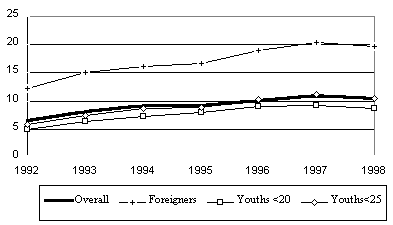
Source: Bundesanstalt für Arbeit (1998 and 1999).
The severe and growing problems for the transition between apprenticeship and employment are especially true for young women. Young persons carry a very high risk of becoming unemployed (they make up 23% of those entering unemployment), but they succeed relatively soon in ending unemployment. So the average duration of unemployment for those under the age of 20 is 4.6 months, for those between 20 and 24 4.9 months, compared to 8.4 months for all unemployed persons. Only 10% of under 25-year-olds have been unemployed for one year or longer (overall average: 36%). Some 59% of the unemployed youths had not completed an apprenticeship (men: 63%, women: 55%).
[page-number of print edition: 63]
The rate of foreigners among unemployed youths is at 23% ten points higher than their percentage among youths holding jobs subject to social security (13%).
The integration of young persons into the labour market is strongly supported by job placement schemes. In addition to those available for all unemployed persons, there are extra measures especially for youths. Around 200,000 young persons are included in employment schemes and measures for youths.
Persons 55 years and above account for 22.1% (669,100) of all unemployed persons in West Germany. Their percentage has risen from 10.8% in 1982. Older persons (45-64yrs) carry a much smaller risk of becoming unemployed than young persons (the percentage of 45-64year-olds among those entering unemployment is 23, compared to 31% of this age group among all those holding jobs subject to social security); but once they are unemployed, it is much harder for them to find new employment, even if they are well qualified. Thus, the duration of unemployment is 14.1 months, which is almost double that of the average unemployed person. Long-term unemployment hits 54% of 45-64year-olds unemployed persons, the rate rising strongly with age. Only 31% of 45-64year-olds ending unemployment had found a new job, compared to 45% among all unemployed persons. Thus, also older persons depend on employ-ment schemes; in 1997, around 80,000 unemployed persons above 45 or 50 years (depending on requirements of different schemes) took part in such measures.
- Differences by nationality:
Foreigners (521,600 unemployed) have an unemployment rate that is at 20.4% more than double that of Germans at 10.0%. The main reason for that is their comparatively low language and professional qualification. 1997 there were 346,700 foreign men and 174,900 foreign women officially registered as unemployed. Different nationalities are differently affected by unem-
[page-number of print edition: 64]
ployment: The highest unemployment rate can be found among Turkish persons (24.5%), then Greeks (19.7%) and Italians (19.6%). The lowest rate among foreigners - much lower than the overall rate - is the unemployment rate of the French (6.5%). The unemployment rate of foreigners varies greatly among German regions: it is lowest in Bavaria (15.4%) and highest in Bremen (29.8%). The rate of long-term unemployment of foreigners is lower than the average long-term unemployment rate; foreigners succeed in finding new employment faster or resign from the labour market and retreat to the hidden reserves earlier than German unemployed persons.
- Differences by health status:
Persons with health problems made up a quarter of all unemployed persons in 1997. Their unemployment lasted an average of 12.6 months, and 48% (almost half!) of them have been unemployed for one year or longer. Only 29% ended their unemployment by finding a new job. Severely disabled persons (163,900) had an unemployment rate of 17% (overall average: 11%).
- Differences by country of origin among Germans:
Immigrants of German origin pose a special problem on the German labour market. Most of them have a very limited knowledge of the German language, and their qualifications were acquired in economic systems that differ greatly from the German one. Some 98% of 1998 immigrants of German origin have lived in countries of the former Soviet Union before, 1.3% came from Poland, 0.5% from Romania. Their unemployment rate cannot be calculated because they are counted as German nationals in the statistics. The numbers of registered unemployed immigrants of German origin have gone down since the begin-
[page-number of print edition: 65]
ning of the 90´s - as have the overall numbers of immigrants of German origin to West Germany (almost 400,000 in 1990, around 175,000 between 1991 and 1995, falling to 107,535 in 1997). The number of unemployed immigrants of German origin has varied between 130,000 and 160,000 and is at 131,890 in September 1997. Other 60,000 have begun German language courses. This number has gone down continuously since the peak at 175,000 in 1990. About 25,000 have started vocational training.
- Differences by qualification:
About 44% of the persons entering unemployment in 1997 had no completed apprenticeship and were unskilled labourers. Their percentage among those in jobs subject to social security is 24%. The duration of their unemployment is at 9 months only slightly longer than the average duration of an unemployment of 8.4 months. Only older, unskilled unemployed persons make up a high percentage of all unemployed persons (the unemployment rate of unskilled persons was 20% in 1995). Of those unqualified persons who end unemployment, only 36% find a new job. Almost 100,000 unskilled persons took part in training and qualification measures.
- Differences by the duration of unemployment:
A great problem on the current labour market is the growing number of long-term unemployed persons, those who have been unemployed for one year or longer. They make up more than a third of all unemployed persons (34% in 1997, even 37% in 1998). The percentage of long-term unemployment was at 12.9% in the early eighties and has risen and stayed between 25% and 34% from 1983 onward (compare Figure 7). In 1997, the rate of long-term unemployed women was 35%, that of long-term unemployed men was 33%.
[page-number of print edition: 66]
Table 1
Long-term unemployment among different groups of unemployed persons in West Germany in 1997 in % (September 1997)
|
Groups |
Rate of Long-term
|
|
Overall |
36,1 |
|
Men |
36,0 |
|
Women |
36,1 |
|
Germans |
36,9 |
|
Foreigners |
32,2 |
|
White-collar Workers |
33,9 |
|
Blue-collar Workers |
37,4 |
|
Unqualified |
38,0 |
|
Completed Apprenticeship |
34,4 |
|
With Health Problems |
48,3 |
|
Severely Disabled Persons |
50,8 |
|
Youths <20 |
3,5 |
|
Youths 20-24 |
10,3 |
|
Persons 45-49 |
40,4 |
|
Persons 50-54 |
48,7 |
|
Persons 54-59 |
62,5 |
|
Persons 60-64 |
54,5 |
Source: Bundesanstalt für Arbeit (1998a): 131.
The September numbers in Figure 8 show slight variations from the yearly average. The percentage of women among long-term unemployed persons is higher than that among all unemployed. Persons 45 years and above (54%) and persons with health problems (48%) are the groups that are most affected by
[page-number of print edition: 67]
long-term unemployment. Also, certain regions with specific structural problems carry a greater risk for higher long-term unemployment. Around 140,000 long-term unemployed persons took part in employment or qualification measures.
The growing numbers and rate of unemployed persons in Germany in 1997 are mainly the result of a greater percentage of persons in long-term unemployment. The average duration of unemployment in West Germany was 32 weeks in 1997, two weeks longer than in 1996. (Bundesanstalt für Arbeit 1998a: 56). The average duration of unemployment for men is 30.8 weeks, while women are unemployed for an average of 34.5 weeks (Bundesanstalt für Arbeit 1998a: 104, 106). But even with a shorter duration of average unemployment - it went down to 30 weeks in 1998, the rate of long-term unemployed persons has risen again in 1998.
6. What Becomes of the Unemployed?
In 1997, 4,926,303 persons registered as newly unemployed in West Germany (about 40,000 less than 1996), while 4,822,865 persons ended their unemployment (200,000 more than 1996). Some 45% of those ending unemployment have found a new job (one third through employment office-activities, two thirds through their own initiative). Other 2.52 million persons took other options: retirement (estimated 136,800), disability -pension (66,000), Non-Availability-Privilege, applicable for persons 58 years and above (129,700), vocational training measures (Aus- und Fortbildung, 259,200); of the others, probably many receded to the hidden reserves (Bundesanstalt für Arbeit, 1998a: 54, 62).
[page-number of print edition: 68]
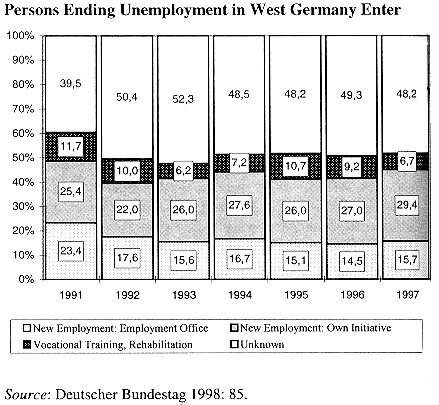
The re-employment rate of men is higher (49.7%) than that of women (38.2%).
In recent years, the rate of those ending unemployment with unknown destination was around 50%. In 1991 this rate was 39.5% (see Figure 9).
So, large groups have problems in finding and keeping their jobs. The greatest problems have those with no or low qualification (including language deficiencies), with health impediments, or older persons. It is a great challenge to society to educate and qualify persons from the beginning and keep up a life-long learning process.
[page-number of print edition: 69]
7. Which strategies are most useful for coping with this challenge?
Since the current situation is bad enough, and rationalisation is only just beginning in the service sector, unemployment is likely to become an even greater problem in the near future. Experts have different proposals on how to do deal with that challenge. Different approaches are being discussed. Two very divergent ones among them shall be shortly introduced here:
- The first one is a late-Keynesian approach that calls for a reduction of working hours, an expansion of personal services, a reduction of income inequalities through different tax and income strategies. It also calls for reforms in educational, innovation, industrial and labour market policies. A greater involvement of government and the state should enlarge paid labour (Memo-group: Hickel ).
- The opposite approach is being followed by a commission reporting to Saxony and Bavaria: It calls for a greater individual responsibility, mobility, and flexibility, for a substantial reduction of the average income and thus of the standard of living for most of the population, for an increase of personal services, and for a reduction of individual labour market activity, thus paid work (but an increase for „rewarded„, thus voluntary, work, civil work) (Kommission: Miegel, Beck).
German politicians are reacting to the current challenges by encouraging a treaty for labour between unions and employers. Considering the enormous effort needed, it is probably too little - the problem about doing more would definitely be to decide which way between those radical strategies to chose, and find support and backing by a majority of the population. Among the population, discussions have not even begun.
[page-number of print edition: 70]
NOTE
1An open question was used that could be answered by one or two entries: 83% for unemployment in December 1998, 75% in January 1999
REFERENCES
BUNDESANSTALT FÜR ARBEIT (Ed.) (1998a): Amtliche Nachrichten der Bundesanstalt für Arbeit (ANBA). Sondernummer: Arbeitsmarkt 1997, 46. Jahrgang, Nürnberg: 12.6.1998.
BUNDESANSTALT FÜR ARBEIT (Ed.) (1998b): Amtliche Nachrichten der Bundesanstalt für Arbeit (ANBA). Sondernummer: Arbeitsstatistik 1997 - Jahreszahlen, 46. Jahrgang, Nürnberg: 31.8.1998.
BUNDESANSTALT FÜR ARBEIT (Ed.) (1999a): Die Entwicklung des Arbeitsmarktes im Dezember und im Jahr 1998. Pressemitteilung Nr. 03/99 vom 08. Januar 1999.
BUNDESANSTALT FÜR ARBEIT (Ed.) (1999b): Die Entwicklung des Arbeitsmarktes im Januar 1999. Pressemitteilung Nr. 06/99 vom 09. Februar 1999.
BUNDESANSTALT FÜR ARBEIT (Ed.) (1998 and 1999): Referat IIIa4. Arbeitsmarktstatistik. Various Data on the Labor Market in Germany. Also available through the Internet (www.arbeitsamt.de).
DEUTSCHER BUNDESTAG (Ed.) (1998): Jahresgutachten 1998/99 des Sachverständigenrates zur Begutachtung der gesamtwirtschaftlichen Entwicklung. Bonn: Drucksache 14/73, 20.11.98.
FORSCHUNGSGRUPPE WAHLEN (1999): Die wichtigsten Themen im Januar. Mannheim.
STATISTISCHES BUNDESAMT (Ed.) (1997): Datenreport 1997. Zahlen und Fakten über die Bundesrepublik Deutschland. Bonn: Bundeszentrale für politische Bildung.
© Friedrich Ebert Stiftung | technical support | net edition fes-library | Februar 2000
